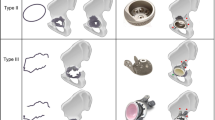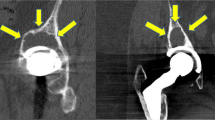Summary
In M. Perthes a progressive deformation and flattening of the epiphysis is caused by the stress in the hip. In the beginning stages a varisation osteotomie gives a sufficient reduction of the joint pressure and a modelling of the enlarged head by the acetabulum is possible. In later stages a detoriation of the head deformity with fixed adduction contracture can be caused by varisation osteotomie.
Enlarging the acetabulum laterally and ventrally and medializing the hip joint by means of a Chiari pelvic-osteotomy reduces the joint pressure so far, that a restitution of the hip joint with round and congruent joint surfaces can be expected. A lateralisation of the deformed femoral head with a secondary insufficiency of the acetabulum should also be treated by an additional pelvic osteotomy, if in the arthrography the lateral part of the head does not enter the acetabulum in abduction position. In secondary osteochondritis in hip luxation the treatment should be equal.
Even an advanced secondary osteoarthritis after M. Perthes could be stopped by pelvic osteotomy over years.
Zusammenfassung
Beim M. Perthes kommt es im Verlauf der Regeneration der vorgeschädigten Epiphyse zu einer fortschreitenden Deformierung und Verbreiterung derselben. Während im Frühstadium durch eine varisierende Femurosteotomie eine ausreichende Entlastung and Modellierung des deformierten Kopfes durch die Pfanne erzielt wird, kann in späteren Stadien die Osteotomie sogar zu einer Verschlechterung und fixierter Adduktionskontraktur führen.
Mittels einer Beckenosteotomie nach Chiari kann durch die Vergrößerung des Pfannendaches nach ventral und nach lateral und durch die Medialverschiebung des Hüftgelenkes der Gelenkdruck so weft verringert werden, daß eine Restitution des Hüftgelenkes mit runden und kongruenten Gelenkskörpern zu erwarten ist. Eine sekundäre Pfanneninsuffizienz durch die Pfannenbodenverdickung sollte ebenfalls durch eine zusätzliche Beckenosteotomie behandelt werden, wenn in Abduktionsstellung in der Arthrographie der laterale Kopfanteil nicht in die Pfanne eintritt. Das gleiche gilt beim Luxationsperthes.
Eine schon fortgeschrittene Sekundärarthrose nach M. Perthes konnte mit dieser Methode ebenfalls durch Jahrzehnte zum Stillstand gebracht werden.
Similar content being viewed by others
Literatur
Axer, A.: Subtrochanteric Osteotomy in the Treatment of Perthes Disease; a Preliminary Report. J. Bone Jt. Surg. 47 B, 489–499 (1965)
Bauer, R., Jünger, H.: Die intertrochantäre Varisationsosteotomie zur Behandlung des M. Perthes. Arch. orthop. Unfall-Chir. 79, 187–204 (1974)
Bertrand, P.: Traitment Chirurgical de la Coxa plana. X. Congrés SICOT, Tables ronde, 66–69 (1966)
Chiari, K.: Die Beckenosteotomie in der Behandlung der Coxarthrose. Beitr. Orthop. Traumatol. 15/3, 163–168 (1971)
Craig, W. A., Kramer, W. G., Watanabe, R.: Etiology and Treatment of Legg-Calvé-Perthes Disease. J. Bone Jt. Surg. 45 A, 1325 (1963)
Hackenbroch, M.: Handbuch der Orthopädie, IV/1. Stuttgart: Thieme 1961
Hördegen, K. M., Witt, A. N.: Erfahrungen mit der intertrochantären Varisationsosteotomie bei Legg-Calvé-Perthes-Er-krankung. Arch. orthop. Unfall-Chir. 70, 320–339 (1971)
Kirsch, K.: Die juvenile Osteochondrose des Hüftgelenkes. Handbuch der Orthopädie, IV/1. Stuttgart: Thieme 1961
Lequesne, M.: Die Erkrankungen des Hüftgelenkes beim Erwachsenen. Acta Rheumat. Geigy 17b, 45 (1967)
Müller, M.: Die hüftnahen Femurosteotomien, 2. Aufl. Stuttgart: Thieme 1970
Pauwels, F.: Gesammelte Abhandlungen zur funktionellen Anatomie des Bewegungsapparates. Berlin-Heidelberg-New York: Springer 1965
Ratcliff, A. H. G.: Pseudocoxalgie, a Study of late Results in the Adult. J. Bone Jt. Surg. 38 B, 498 (1956)
Salter, R. B.: Experimental and ClinicalAspects of Perthes Disease. J. Bone Jt. Surg. 48 B, 393–394 (1966)
Schmidt, W.: Endausgang der Osteochondrosis coxae juvenilis. Beitr. klin. Chit. 1960, 247 (1934)
Sceur, R., De Racker, Ch.: Aspect Anatomopathologique de L'Osteochondrite et le Theories pathogeniques qui s'y rapportent. Acta orthop. Belg. 18, 57 (1952)
Sommerville, E. W.: Perthes Disease. J. Bone Jt. Surg. 43 B, 855 (1961)
Sommerville, E. W.: Perthes Disease of the Hip. J. Bone Jt. Surg. 53 B, 639–645 (1971)
Sundt, H.: Further Investigations Respecting Malum Coxae Calvé-Legg-Perthes with Special Regard to Prognosis and Treatment. Acta orthop. Scand. 99, 472–475 (1950)
Zweymüller, K., Wicke, B.: Zur Lateralisation des Oberschenkelkopfes beim M. Perthes. Arch. orthop. Unfall-Chir. 75, 239 (1973)
Author information
Authors and Affiliations
Rights and permissions
About this article
Cite this article
Chiari, K., Endler, M. & Hackel, H. Die behandlung der coxa magna bei M. Perthes mit der beckenosteotomie. Arch. Orth. Traum. Surg. 91, 183–190 (1978). https://doi.org/10.1007/BF00379749
Received:
Issue Date:
DOI: https://doi.org/10.1007/BF00379749




